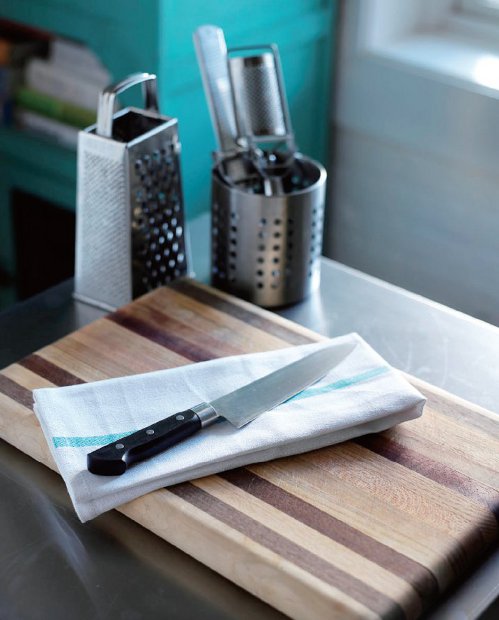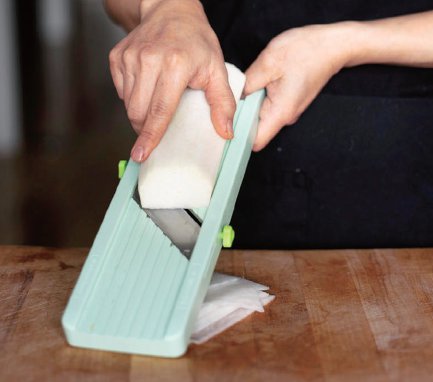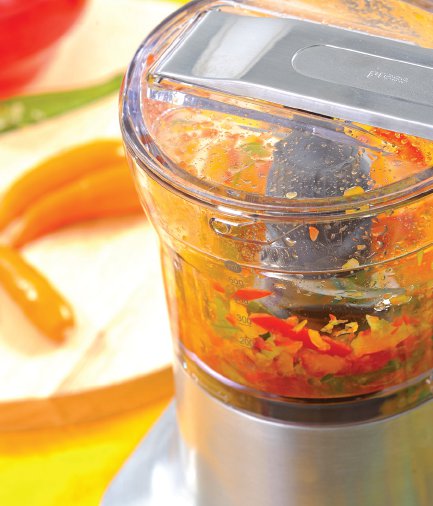
TOOLS AND EQUIPMENT
KNIVES. The number one question in my culinary classes is “How do I improve my knife skills?” My answer: “It’s not you, it’s the knife. Get a great chef’s knife.” By that, I don’t necessarily mean a heavy-handed, 12-inch, samurai-style one such as you might see Mario Batali wielding. That may be perfect for him, but it’s not for everybody. I, for one, have small hands, and my wrists hurt when I use a knife that’s heavy, so I opt for a smaller, lighter chef’s knife, and I keep it sharpened at all times. A dull knife is not only dangerous but joyless to cook with (prepping is a chore when your knife is dull and cumbersome). Find a knife that works for you, and your knife skills will automatically improve.
A serrated knife is great for cutting baguettes and other crusty breads, but when I get a chance to eat high-quality bread, believe me, I’m not cutting it, I’m tearing it. If you already have a serrated knife, great, but if not, there’s no need to run out and buy one. A sharp chef’s knife is really all you need. However, a paring knife, which is small with a curved blade, is useful for cutting small ingredients and peeling fruits.
HAND GRATER OR SHREDDER. A hand grater or shredder is incredibly useful. The box grater has different-size holes on each side, so it is the most versatile. I use it to zest citrus fruits, grate cheeses, shred vegetables such as carrots and cabbage, and even make cauliflower “rice.”
HAND PEELER. A hand peeler is useful not only for peeling skin off vegetables but for creating vegetable “ribbons.” For example, I like to make cucumber ribbons and roll two layers together to make cucumber rolls stuffed with avocado.
JULIENNE PEELER. A julienne peeler is similar to a hand peeler but it has teeth, so it perforates your vegetables into beautiful, thin strips. It is a great gadget, perfect for making zucchini “spaghetti” as well as numerous types of vegetable slaws and garnishes.
FILE ZESTER. A file zester is a must for fine-zesting citrus, mincing ginger or garlic, and grating whole nutmeg. I recommend the Microplane brand.
GARLIC PRESS. A garlic press is efficient for mincing garlic and peeled ginger. Personally, I don’t like having to clean a garlic press, so I prefer to mince small amounts by hand, or if I need more in a hurry, I’ll use a mini food processor.
STEAMER. You can get a bamboo steamer that fits snugly over a pot or a stainless steel one that can be set into a pot. I have both. You can also rig a metal colander into a pot and not even buy one.
CITRUS JUICER. A manual citrus juicer for lemons, limes, and small grapefruits is ideal because it captures 95 percent of the juice, compared to an electric juicer, which is not as efficient. Besides, it is one less piece of equipment that you have to plug in.

MANDOLINES are very useful for an array of raw dishes. I use one not only for finely slicing vegetables in general, but also for preparing daikon sheets that serve as wraps for rolls, as well for preparing butternut “lasagna” pasta. Please be careful when using a mandoline, and always use the protective guard, since the blades are notorious for nicking fingers.
A SPIRALIZER is a raw foodist’s special gadget. It “spiralizes” vegetables into long, curled strips and is perfect for making raw “spaghetti.” It is so fun to use that I am never short on volunteers when I need a big batch of spiralized vegetables made. I like the Spirooli brand, which comes with three different blades with two different hole sizes and a slicing blade.
QUALITY POTS AND PANS are worth the investment as they will serve you beautifully for life. They should be uncoated and made of pure metal—stainless steel, cast iron, and/or copper. Opt for metal handles, as opposed to wood or plastic, so you can easily pop them into the oven when necessary.
NONSTICK PANS are coated with materials that should never make contact with food during the heating process. Using a small amount of coconut oil, water, or organic butter will create a nontoxic, nonstick surface, so skip the Teflon coating. As soon as these synthetic coatings reach certain temperatures, they release toxins that will become a part of any dish you prepare.
a note about aluminum and nonstick pans
ALUMINUM SHOULD NEVER BE USED FOR COOKWARE. PURCHASE CAST-IRON OR COPPER POTS AND PANS, OR STAINLESS STEEL COOKWARE WITH A COPPER CORE. MOST COMPANIES USE AN ALUMINUM CORE IN THEIR STAINLESS STEEL PANS FOR HEAT DISTRIBUTION, CLAIMING THAT ENCAPSULATING THE ALUMINUM WILL PROTECT THE FOOD FROM IT DURING THE HEATING PROCESS. WELL, UNTIL WE KNOW FOR SURE, IT’S BETTER TO BE SAFE THAN SORRY.
OTHER ESSENTIALS that you need to have on hand include: cutting boards (it is best to have a couple, keeping one aside for seafood and meats, if applicable), mixing bowls, rubber spatulas (for scraping up the last bits in your food processor or blender), large wooden mixing spoons (stay away from metal spoons as much as possible), a salad spinner for fresh herbs and salad greens, and microfiber kitchen towels (I recommend these because they are incredibly absorbent and pick up all the dirt), as well as multipurpose tongs and strainers.
PLUG-INS
I try to limit the number of machines in my kitchen. If I can chop, cut, shred, or blend by hand, it will be my first choice. Prepping by hand develops kitchen skills and strengthens your connection with the food; machines tend to sever that bond. It also makes you slow down and appreciate the meal you are preparing. When my mother gets ready to make her huge vat of kimchi, she spreads out newspapers with dozens of garlic bulbs. We sit around peeling each garlic clove by hand, and although it might take us an hour, it is time well spent and in good company.
All that said, I must admit that some electronic kitchen aids are time-savers and incredibly efficient. I have found the following appliances to be worthy investments.
A HIGH-SPEED BLENDER with variable speeds can whip up soups, purees, dressings, sauces, puddings—just about anything—with ease. Having the variable speed option gives you more control and allows you to blend as much or as little as you like. If you are new to preparing blended foods, a regular blender will do, but as you grow with these recipes, you will start yearning for the real deal.
FOOD PROCESSORS come in different sizes. I have a 14-cup-capacity food processor, which is great for making a family-size coleslaw, a half dozen veggie burgers, and an enormous amount of jicama “rice.” If you don’t cook in large quantities like I often do, buy a medium-capacity food processor. But in any case, be sure to get one with two different blades: one for grinding, and the other for mincing and chopping. A shredding and slicing disk is also a great addition.
A JUICER is a no-brainer and the best possible investment for you and your family. For juicing every day, a centrifugal juicer will do, and there are plenty of worthy brands on the market. I have a Breville that has stood by me for years. (However, my Breville has recently taken a backseat to my new love, the Norwalk Juicer, which allows you to make up to 3 days’ worth of fresh-pressed juices with minimal enzymatic loss. It’s a serious and expensive piece of machinery, though, so unless you’re a professional juicer or can easily afford it, I’d recommend a more basic model.)
MORE FUN KITCHEN AIDS can make your life easier. I also recommend getting an ice cream maker (because we have some wonderful recipes that will change the way you look at ice cream and sorbets); a spice grinder for whole spices; and, last but not least, a dehydrator as a luxury item, in case you want to make the kale chips.
